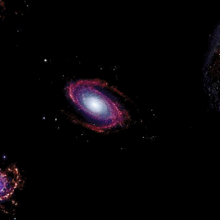Big Crunch

| Part of a series on |
| Physical cosmology |
|---|
 |
|
|
The Big Crunch is a hypothetical scenario for the ultimate fate of the universe, in which the expansion of the universe eventually reverses and the universe recollapses, ultimately causing the cosmic scale factor to reach zero, an event potentially followed by a reformation of the universe starting with another Big Bang. The vast majority of evidence indicates that this theory is not correct. Instead, astronomical observations show that the expansion of the universe is accelerating, rather than being slowed by gravity, suggesting that the universe is far more likely to end in heat death or a Big Rip.[1][2][3]
Overview[]
The Big Crunch scenario hypothesized that the density of matter throughout the universe is sufficiently high that gravitational attraction will overcome the expansion which began with the Big Bang. The FLRW cosmology can predict whether the expansion will eventually stop based on the average energy density, Hubble parameter, and cosmological constant. If the metric expansion stopped, then contraction will inevitably follow, accelerating as time passes and finishing the universe in a kind of gravitational collapse.
A more specific theory called "Big Bounce" proposes that the universe could collapse to the state where it began and then initiate another Big Bang, so in this way the universe would last forever, but would pass through phases of expansion (Big Bang) and contraction (Big Crunch).[4]
Experimental evidence in the late 1990s and early 2000s (namely the observation of distant supernovae as standard candles, and the well-resolved mapping of the cosmic microwave background)[5] led to the conclusion that the expansion of the universe is not being slowed by gravity but is instead accelerating. The 2011 Nobel Prize in Physics was awarded to researchers who contributed to making this discovery.[1]
Physicist Roger Penrose advanced a general relativity based theory called the conformal cyclic cosmology in which the universe expands until all the matter decays and is turned to light. Since nothing in the universe would have any time or distance scale associated with it, it becomes identical with the Big Bang (resulting in a type of Big Crunch which becomes the next Big Bang, thus starting the next cycle).[6] Penrose and Gurzadyan suggested that signatures of conformal cyclic cosmology could potentially be found in the cosmic microwave background; as of 2020, these have not been detected.[7]
Effects[]
Paul Davies considered a scenario in which the Big Crunch happens about 100 billion years from the present. In his model, the contracting universe would evolve roughly like the expanding phase in reverse. First, galaxy clusters, and then galaxies, would merge, and the temperature of the cosmic microwave background (CMB) would begin to rise as CMB photons get blueshifted. Stars would eventually become so close together that they begin to collide with each other. Once the CMB becomes hotter than M-type stars (about 500,000 years before the Big Crunch in Davies' model), they would no longer be able to radiate away their heat and would cook themselves until they evaporate; this continues for successively hotter stars until O-type stars boil away about 100,000 years before the Big Crunch. In the last minutes, the temperature of the universe would be so great that atoms and atomic nuclei would break up and get sucked up into already coalescing black holes. At the time of the Big Crunch, all the matter in the universe would be crushed into an infinitely hot, infinitely dense singularity similar to the Big Bang.[8] The Big Crunch may be followed by another Big Bang, creating a new universe.
See also[]
- Arrow of time – Concept in physics that time is asymmetric (flowing one way)
- Bentley's paradox – Cosmological paradox involving gravity
- Chronology of the universe – History and future of the universe
- Cyclic model
- Entropy (arrow of time)
- Eternal return – Concept that the universe and all existence is perpetually recurring
- Timeline of cosmological epochs
- Timeline of the far future – Scientific projections regarding the far future
References[]
- ^ Jump up to: a b "The Nobel Prize in Physics 2011". NobelPrize.org. Retrieved 2020-09-27.
- ^ Falk, Dan. "This Cosmologist Knows How It's All Going to End". Quanta Magazine. Retrieved 2020-09-27.
- ^ Perlmutter, Saul (April 2003). "Supernovae, Dark Energy, and the Accelerating Universe". Physics Today. 56 (4): 53–60. Bibcode:2003PhT....56d..53P. doi:10.1063/1.1580050. ISSN 0031-9228.
- ^ "Jennifer Bergman, The Big Crunch, Windows to the Universe (2003)". Archived from the original on 2010-03-16. Retrieved 2009-02-15.
- ^ Wang, Yun; Kratochvil, Jan Michael; Linde, Andrei; Shmakova, Marina (2004). "Current observational constraints on cosmic doomsday". Journal of Cosmology and Astroparticle Physics. 2004 (12): 006. arXiv:astro-ph/0409264. Bibcode:2004JCAP...12..006W. doi:10.1088/1475-7516/2004/12/006. S2CID 56436935.
- ^ Penrose, Roger. "Cycles of Time: An Extraordinary New View of the Universe [Hardcover]." (2011).
- ^ Jow, Dylan L.; Scott, Douglas (2020-03-09). "Re-evaluating evidence for Hawking points in the CMB". Journal of Cosmology and Astroparticle Physics. 2020 (3): 021. arXiv:1909.09672. Bibcode:2020JCAP...03..021J. doi:10.1088/1475-7516/2020/03/021. ISSN 1475-7516. S2CID 202719103.
- ^ Davies, Paul (1997). The Last Three Minutes: Conjectures About The Ultimate Fate of the Universe. Basic Books. ISBN 978-0-465-03851-0.
- Doomsday scenarios
- Physical cosmology
- Ultimate fate of the universe